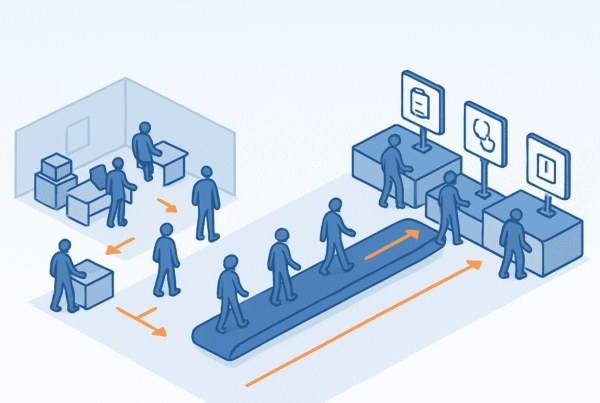If you own a pediatric physical therapy practice in St. Louis, you are in a strong position. The market for pediatric PT is experiencing significant national growth, creating new opportunities for practice owners considering their next steps. This guide provides a clear overview of the St. Louis market, how to understand your practice’s value, and what the sale process involves. It is designed to help you make informed decisions for your future.
Market Overview
A Growing National Tide
The timing for exploring a practice sale is excellent. Nationally, the pediatric physical therapy market is projected to grow at an impressive 8.4% annually through 2031. This is not just a passing trend. The demand for skilled physical therapists is expected to increase by 14% over the next decade, a rate much faster than most other professions. This high demand from patients and a growing pool of buyers create a favorable environment for sellers.
The St. Louis Landscape
In St. Louis, these national trends translate into a dynamic but competitive market. While the demand is strong, so is the a presence of established hospital systems and independent practices. A successful sale here depends on understanding how your practice stands out. Your established referral sources, patient loyalty, and specific service niches are what buyers will scrutinize closely against the local competition.
Beyond the numbers, a potential buyer is purchasing the heart of your practice: your relationship with the community. They will have key questions that you must be prepared to answer. How will you ensure a smooth transition for your young patients and their families? Is your talented staff likely to stay through the change in ownership? The stability of your referral sources and the quality of your payer contracts are not just line items; they are proof of your practice’s long-term health. Thinking through these aspects and having clear, documented answers is a large part of preparing for a successful sale.
Market Activity
Who Is Buying?
The market for physical therapy practices is more active than ever. Buyers range from local or regional PT groups looking to expand their footprint in St. Louis to private equity-backed platforms seeking to build a national presence. These larger, more sophisticated buyers are not just looking for a clinic. They are looking for well-run businesses with strong profitability and a clear path for growth. They have professional teams and move quickly when they find an attractive opportunity.
Creating a Competitive Process
A common mistake is engaging with only the first buyer who shows interest. A single offer is never a measure of your practice’s true market value. The key to maximizing your outcome is to run a confidential, structured process that introduces your practice to a curated group of qualified buyers simultaneously. This creates competition, gives you options, and ensures you are negotiating from a position of strength, not reacting to a single take-it-or-leave-it offer.
Selling your practice is a structured journey, not a single event. While every sale is unique, the process generally follows four main stages. In my experience, owners who understand these steps are far better prepared.
-
Preparation and Valuation. This is the foundational stage, often beginning 1-2 years before you plan to sell. It involves cleaning up financial records, defining your growth story, and getting a professional valuation to set a realistic price expectation.
-
Confidential Marketing. Your practice is presented, without revealing its identity, to a targeted list of qualified buyers. This protects your staff and patients while generating interest from the right kind of partners.
-
Negotiation and Due Diligence. After selecting the best offer, you enter a period where the buyer verifies all financial and operational details. This is the most intensive phase, where proper preparation prevents surprises.
-
Closing and Transition. The final legal documents are signed, and the funds are transferred. A post-sale transition plan is executed to ensure a smooth handover for patients, staff, and referral partners.
How do you determine what your practice is worth? The most common method buyers use is a multiple of your annual cash flow, or EBITDA. This stands for Earnings Before Interest, Taxes, Depreciation, and Amortization. For a practice like yours, the multiple might range from 3x to 8x EBITDA, depending on factors like your size, location, staff depth, and growth trajectory. However, the most important number is not the multiple, but the EBITDA itself. We often find practices are undervalued because their financials haven’t been “normalized.” A professional advisor will adjust your EBITDA for owner-specific expenses and one-time costs, presenting a true picture of profitability that can significantly increase your final valuation.
Your work is not finished the day the deal closes. How the sale is structured will define your role, your financial outcome, and your legacy. It is important to decide what you want your future to look like early in the process, as this will guide negotiations. Your main options often include:
| Post-Sale Option | Your Involvement | Potential Outcome |
|---|---|---|
| Clean Break | You exit the practice completely at closing. | Immediate liquidity, but no future upside. |
| Transitional Role | You stay on for 6-24 months to ensure stability. | May include an “earnout” to be paid if goals are met. |
| Equity Partnership | You roll a portion of your sale price into a new company. | Lower cash at close, but potential for a second, larger payday later. |
Each path has major implications for your tax burden and long-term wealth. Planning for your post-sale life is just as important as planning for the sale itself.
Frequently Asked Questions
What is the current market outlook for pediatric physical therapy practices in St. Louis?
The pediatric physical therapy market is experiencing significant national growth, with an annual growth rate projected at 8.4% through 2031. St. Louis reflects this trend but also features a competitive environment with established hospital systems and many independent practices. Demand for skilled pediatric physical therapists is high, creating favorable conditions for practice sales.
How is the value of my pediatric physical therapy practice determined?
Practice value is commonly based on a multiple of your annual cash flow or EBITDA (Earnings Before Interest, Taxes, Depreciation, and Amortization). For pediatric PT practices, this multiple ranges typically from 3x to 8x EBITDA, influenced by factors like practice size, location, staff strength, and growth potential. Proper normalization of financials to remove owner-specific expenses improves valuation accuracy.
What should I consider to prepare my practice for sale?
Preparation usually starts 1-2 years before sale and includes cleaning up financial records, clarifying your growth story, and obtaining a professional valuation. Documenting stable referral sources, payer contracts, and staff retention plans is crucial. Planning your future involvement post-sale also helps guide negotiations and transition planning.
Who are the typical buyers of pediatric physical therapy practices in St. Louis?
Buyers range from local and regional physical therapy groups aiming to expand their footprint to private equity-backed platforms looking to build national networks. They seek profitable, well-run businesses with clear growth potential. Running a confidential, competitive marketing process helps find the best offers from multiple qualified buyers.
What are my options after selling the practice, and how do they impact me?
You can choose a clean break (exiting fully at closing for immediate liquidity), a transitional role (staying 6-24 months often with an earnout opportunity), or an equity partnership (reinvesting part of the sale price for potential future gains). Each affects your tax obligations, financial outcomes, and legacy, so early planning is vital to meet your personal and financial goals.



